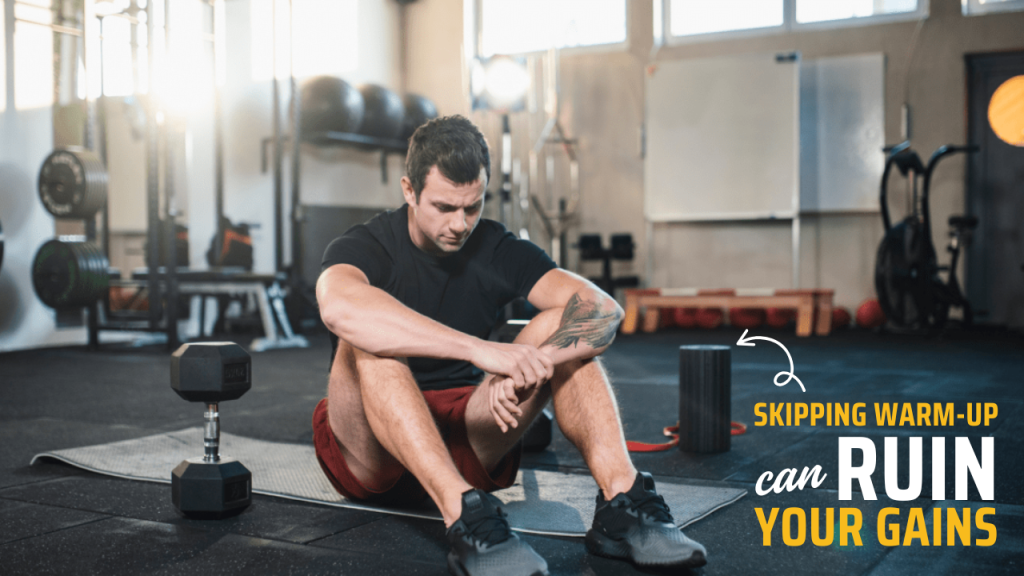“You don’t build a house without laying a solid foundation—so why are you building your body without warming it up first?”
Most gym-goers and fitness enthusiasts are laser-focused on the main event—the intense lifts, sweaty HIIT sessions, or challenging cardio drills. But here’s the truth many ignore: skipping your warm-up exercise might just be the silent killer of your progress.
Yes, we’re talking about sabotaged gains, increased injury risk, and sluggish performance—all because you didn’t spend 5–10 minutes preparing your body.
Let’s dig into the science, the impact on your performance, and why warming up isn’t optional—it’s essential.

What Happens to Your Body During a Warm-Up?
A proper warm-up does more than get your heart rate up. It prepares your muscles, joints, nervous system, and even your mental focus for the demands ahead.
Here’s what actually happens:
- Increased blood flow to muscles: Helps deliver oxygen and nutrients efficiently.
- Improved joint lubrication: Reduces stiffness and enhances range of motion.
- Activation of the nervous system: Improves coordination and reaction time.
- Elevated core temperature: Optimizes enzyme activity for muscle contractions.
In short, your body transitions from rest mode to “go mode.” Skipping this transition is like going from 0 to 100 without warming the engine—it causes long-term damage.
Why Skipping Warm-Ups Is Sabotaging Your Gains
1. Reduced Muscle Performance
Without a warm-up, your muscles aren’t fully activated. That means you’re not recruiting as many muscle fibers during your lifts, leading to less strength output and ultimately fewer gains over time.
Study Insight: Research published in the Journal of Strength and Conditioning Research found that athletes who performed dynamic warm-ups had significantly better strength and power output than those who didn’t.
2. Increased Risk of Injury
Cold muscles are tight, less elastic, and prone to tears. Without preparing your joints and connective tissues, you’re opening the door to pulled hamstrings, strained shoulders, or worse—long-term injuries that can derail your progress for weeks or months.
3. Poor Mind-Muscle Connection
Warming up helps you mentally connect with your body. It primes the mind-muscle link, which is crucial for effective training—especially in bodybuilding or hypertrophy-focused workouts.
4. Decreased Metabolic Efficiency
When you skip warm-ups, your metabolic systems (like ATP production) aren’t fully engaged. That means you may feel sluggish, fatigued early, or unable to perform at your highest intensity.
The Science-Backed Warm-Up Formula
A good warm-up isn’t about running on the treadmill for five minutes. It should be goal-oriented, specific, and systematic.
Try this structure:
- General Warm-Up (3–5 minutes)
Light cardio (e.g., jumping jacks, brisk walking, cycling) to elevate your heart rate. - Dynamic Stretching (5 minutes)
Focus on movements that mimic your workout—leg swings, arm circles, and bodyweight squats. - Activation Drills (3–5 minutes)
Glute bridges, shoulder taps, and band pull-apart to activate key muscle groups. - Movement-Specific Prep (1–2 sets)
Perform lighter sets of your main exercise (e.g., warm-up squats before heavy squats).
Unique Tip: Warm-Up for Your Workout Type
Different workouts require tailored warm-ups. Here’s a breakdown:
| Workout Type | Suggested Warm-Up |
|---|---|
| Weightlifting | Dynamic stretches + light compound lifts |
| HIIT/Cardio | Skipping rope, leg swings, short sprints |
| Yoga or Mobility | Controlled joint rotations, deep breathing |
| Athletic Training | Plyometrics, agility ladder, light drills |
Mental Gains: The Hidden Benefit of Warming Up
Warming up isn’t just physical—it boosts mental readiness. It builds anticipation, sharpens focus, and gets you into a “performance mindset.” This psychological edge can help you push harder, stay consistent, and stay safe.
Final Thoughts: No Warm-Up = No Progress
If you’re investing hours at the gym but still struggling to see results, your warm-up (or lack thereof) might be the culprit.
Takeaway: Warming up is not a waste of time—it’s an investment in your progress, strength, and longevity. Skip it, and you’re not just risking injury—you’re cheating yourself out of the gains you worked so hard for.
Next time you’re tempted to dive straight into the workout—pause, warm up, and let your body lead the way.
Frequently Asked Questions (FAQs)
How long should a warm-up last before a workout?
A proper warm-up should last 5 to 10 minutes, depending on the intensity and type of workout. Higher-intensity sessions or heavy lifting routines may require a slightly longer warm-up to fully prepare the muscles and nervous system.
What is the difference between a warm-up and stretching?
A warm-up involves light aerobic and dynamic movements to raise body temperature and activate muscles. Stretching, especially static stretching, focuses on elongating muscles and improving flexibility. Stretching is better suited for the cool-down phase, while dynamic stretches are ideal for warming up.
Can I skip the warm-up if I’m short on time?
Skipping a warm-up may save time in the short term but can lead to poor performance, higher injury risk, and reduced long-term progress. Instead, do a short but effective 3–5 minute dynamic warm-up to at least prep your body safely.
Is it necessary to warm up for bodyweight or light workouts?
Yes. Even for bodyweight exercises like push-ups or squats, warming up helps activate stabilizing muscles, improves movement quality, and prevents overuse injuries—especially in repetitive routines.
Can warming up improve muscle gains?
Yes! A warm-up helps you maximize muscle fiber recruitment, improve workout quality, and reduce the risk of performance setbacks from injuries. Over time, this leads to better strength and hypertrophy gains.
Is warming up important for cardio workouts too?
Absolutely. Whether you’re running, cycling, or rowing, warming up boosts your cardiovascular efficiency, oxygen delivery, and reduces strain on the heart and muscles, especially during high-intensity intervals.





